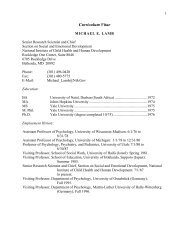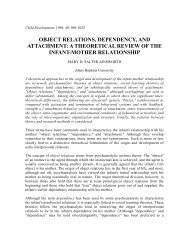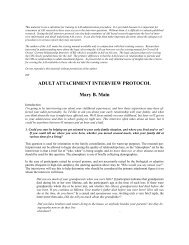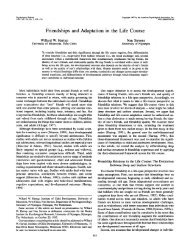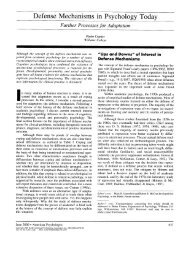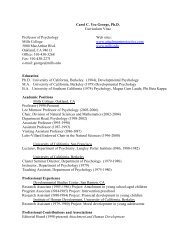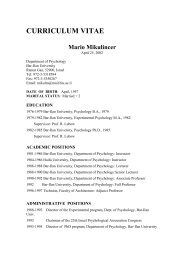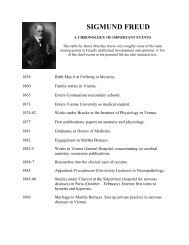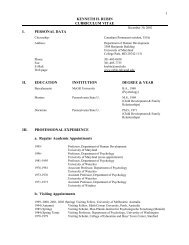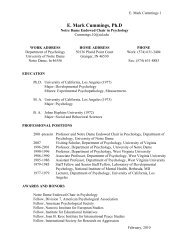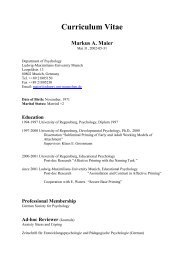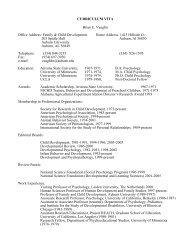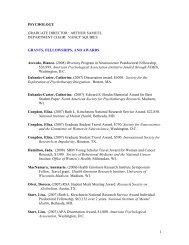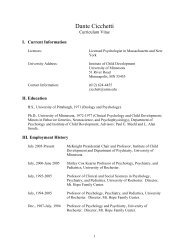the origins of attachment theory: john bowlby and mary ainsworth ...
the origins of attachment theory: john bowlby and mary ainsworth ...
the origins of attachment theory: john bowlby and mary ainsworth ...
You also want an ePaper? Increase the reach of your titles
YUMPU automatically turns print PDFs into web optimized ePapers that Google loves.
make sure that mo<strong>the</strong>rs would feel comfortable enough to follow <strong>the</strong>ir normal routine, resulting<br />
in approximately 72 hours <strong>of</strong> data collection per family.<br />
Raw data took <strong>the</strong> form <strong>of</strong> narrative reports, jotted down in personal shorth<strong>and</strong>, marked in<br />
5-minute intervals, <strong>and</strong> later dictated into a tape recorder for transcription. Typed narratives from<br />
all visits for each quarter <strong>of</strong> <strong>the</strong> first year <strong>of</strong> life were grouped toge<strong>the</strong>r for purposes <strong>of</strong> analysis.<br />
A unique (at <strong>the</strong> time) aspect <strong>of</strong> Ainsworth’s methodology was <strong>the</strong> emphasis on meaningful<br />
behavioral patterns in context, ra<strong>the</strong>r than on frequency counts <strong>of</strong> specific behaviors, This<br />
approach had roots in her dissertation work, in which she classified patterns <strong>of</strong> familial <strong>and</strong><br />
extrafamilial dependent <strong>and</strong> independent security, in her expertise with <strong>the</strong> Rorschach test, <strong>and</strong> in<br />
her work at <strong>the</strong> Tavistock Institute with Bowlby <strong>and</strong> Robertson.<br />
Close examination <strong>of</strong> <strong>the</strong> narratives revealed <strong>the</strong> emergence <strong>of</strong> characteristic mo<strong>the</strong>r-infant<br />
interaction patterns during <strong>the</strong> first 3 months (see Ainsworth et al., 1978; see also Ainsworth,<br />
1982, 1983). Separate analyses were conducted on feeding situations (Ainsworth & Bell, 1969),<br />
mo<strong>the</strong>r-infant face-to-face interaction (Blehar, Lieberman, & Ainsworth, 1977), crying (Bell &<br />
Ainsworth, 1972), infant greeting <strong>and</strong> following (Stayton & Ainsworth, 1973), <strong>the</strong> <strong>attachment</strong>-<br />
exploration balance (Ainsworth, Bell, & Stayton, 1971), obedience (Stayton, Hogan, &<br />
Ainsworth, 1973), close bodily contact (Ainsworth, Bell, Blehar, & Main, 1971), approach<br />
behavior (Tracy, Lamb, & Ainsworth, 1976), <strong>and</strong> affectionate contact (Tracy & Ainsworth,<br />
1981).<br />
Striking individual differences were observed in how sensitively, appropriately, <strong>and</strong><br />
promptly mo<strong>the</strong>rs responded to <strong>the</strong>ir infants’ signals. For some mo<strong>the</strong>r-infant pairs, feeding was<br />
an occasion for smooth cooperation. O<strong>the</strong>r mo<strong>the</strong>rs had difficulties in adjusting <strong>the</strong>ir pacing <strong>and</strong><br />
behavior to <strong>the</strong> baby’s cues. In response, <strong>the</strong>ir babies tended to struggle, choke, <strong>and</strong> spit up,<br />
hardly <strong>the</strong> sensuous oral experience Freud had had in mind. Similar distinctive patterns were<br />
observed in face-to-face interactions between mo<strong>the</strong>r <strong>and</strong> infant during <strong>the</strong> period from 6 to 15<br />
weeks (Blehar et al,, 1977). When mo<strong>the</strong>rs meshed <strong>the</strong>ir own playful behavior with that <strong>of</strong> <strong>the</strong>ir<br />
babies, infants responded with joyful bouncing, smiling, <strong>and</strong> vocalizing. However, when mo<strong>the</strong>rs<br />
initiated face-to-face interactions silently <strong>and</strong> with an unsmiling expression, ensuing interactions<br />
were muted <strong>and</strong> brief. Findings on close bodily contact resembled those on feeding <strong>and</strong>



